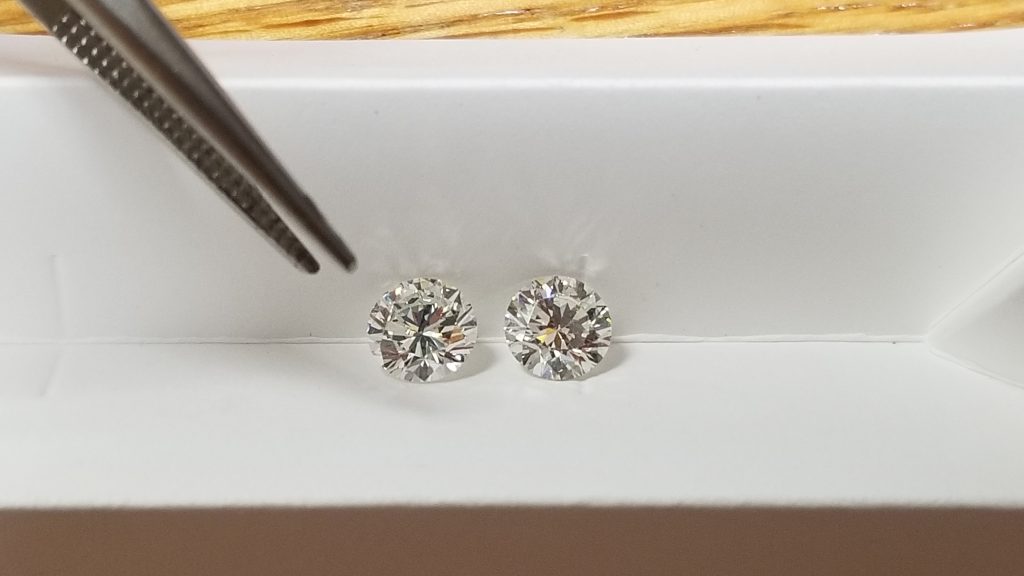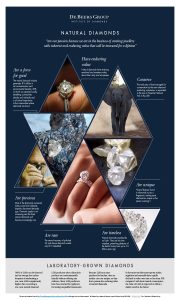
I’m sure by now you’ve come across the term 'lab-grown' when referring to diamonds. There has been a lot of buzz in the press recently, with some high street brands shouting about them. They’ve been championing the fact that they’re environmentally friendly. How they can be made to order. How they are much cheaper than natural diamonds. And that’s true. But there is a reason for that.
Given that, and with all the marketing, you’re wondering if you should jump on the bandwagon too. You have FOMO (fear of missing out). If that’s how you feel, then that’s fine. As for me, I have decided not to get involved with lab-grown diamonds for now. It was a fairly simple decision to make.
Let me try and explain things from my perspective.
Put plainly and simply, they aren’t a luxury item.
When you compare lab-grown diamonds to natural diamonds, the difference isn’t in the way they look. It isn’t even in the physical, optical, and chemical characteristics. The difference is lab-grown diamonds are manufactured by man; they didn’t form naturally in the earth. That’s the main difference. And it’s an important one too!
The journey of a natural diamond is long one. Natural diamonds are formed over millions of years. Deep in the earth under remarkable heat and pressure. They travelled for years to the earths surface through volcanic pipes. Ascending to the surface as the result of molten rock and volcanic eruptions. They survived that incredible journey and serve as a reminder of the planet’s conditions billions of years ago. So, it’s fair to say that diamonds are the oldest thing you’ll probably ever touch!
Not every diamond that comes into existence is worthy of being used for jewellery. Only about 10% of diamonds mined end up in a shop window. The rest, because of its hardness, are used for either cutting & polishing gem quality diamonds or make their way onto the end of drill bits for the construction industry, as an example.
And now to lab-grown diamonds. Let me answer a few points. These are the main ones I’ve come across.
Lab-diamonds aren’t real diamonds.
Well, they are real diamonds, in a way. Is ice real if it’s made in your freezer? A crazy analogy I recently heard which blew my mind is this. If a baby was born through artificial insemination, is it a fake baby? Well, no. But isn’t that the point. They are natural, just made in a different way. By machines instead of Mother Nature. And isn’t that the point. Anytime there is interference in the way something is naturally created, it becomes manufactured. Once manufactured it no longer can be called natural.
I’m not here to discredit the value of them. Everything has a value. Can one tell the difference between lab-grown and natural? Yes. Can one tell the difference easily? No. But if you’re going to go to the expense of passing off a lab-grown for a natural, why not save some cash and get a Moissanite or a cubic zirconia?
In my view, the only reason you want a lab-grown diamond is to achieve the same look for less. But remember, it’s not a natural. And a natural is where the romance is. A natural is where the history is. A natural is what she wants.
Lab-created diamonds are cheaper. And I understand that sometimes what we really want is out of our price range. But then Moissanite is cheaper than lab-grown and those are very difficult to distinguish between too. It’s a different product and it’s important to remember that.
Yes, but lab-grown diamonds will save the planet.
WHHAAATTT!! Now look, I’m all for saving the planet and looking after it for our kids. After all, I have three and I want to do what I can for them too. But surely this is a massive misrepresentation. If you investigate the way that diamonds are mined today, you will see that the mining companies act responsibly and take very good care of our planet. Certain procedures were put in place years ago to ensure there was complete transparency and that the mining companies were acting responsibly. Once a mine has given up its treasures, the mining companies ensure that the holes are filled, and that nature is restored. Trees are replanted and animal habitats are reintroduced to the area.
Lab-grown diamonds, on the other hand, take away jobs and livelihoods from towns, cities and countries who depend on, and rely on, the mining in that region. Often, because of where these mines are located, these countries are impoverished, and the income and jobs that are produced can, and do, help many people out of poverty. Lab-grown diamond producers often claim that their products are environmentally friendly without offering an evidence. It take a vast amount of electricity to produce one stone. That can't be great for our environment and the planet. But that's a side issue
Think of a Van Gough painting. A lot of us like art. Some even have replicas on our walls adorning our home. And if you had the choice, I’m sure you would want an original. There is nothing wrong with a framed copy. The difference between the copies can be incredible. You could have a lithograph or a photocopy. Ultimately those aren’t the original and therefore they aren’t a luxury item. Would you let other people know that your lab-grown diamond is not a 'natural'? And your lab-grown diamond will be laser engraved 'lab-grown' by the grading laboratory.
So, there you have it. Lab-created diamonds are in fact real diamonds and offer the same brilliance, sparkle, and shine of a natural, mined diamond. If you want a cut-price diamond that looks the same, lab-grown diamonds are an option to consider. And so too are Moissanite and cubic zirconia’s. But be aware of the long-term implications when choosing a lab diamond over a natural diamond. Is it just a fad and a severe case of FOMO? If that’s the case, then you can easily end up with buyer’s remorse.
For now, this is why I decided not to deal with lab-grown diamonds. As I stated at the top of this article, I only deal with luxury goods, and lab-grown diamonds are not a luxury.
[Updated 24 Feb 2023]
Here are three potential disadvantages of buying and owning a lab-grown diamond.
- Resale value: Unlike natural diamonds, lab-grown diamonds may not hold their value as well over time. This is because they are still a relatively new product, and there is not yet a well-established market for them. As a result, if you buy a lab-grown diamond and later decide to sell it, you may not be able to get as much money for it as you would a natural diamond.
- Perception: While lab-grown diamonds are chemically and physically identical to natural diamonds, some people may still perceive them as "fake" or "less valuable" than natural diamonds. This perception may not be shared by everyone, but it could be a concern if you are buying a diamond as an investment or for a special occasion where the value and perception of the diamond matter.
- Limited availability: While the production of lab-grown diamonds is increasing, they are still not as widely available as natural diamonds. This means that you may have a more limited selection to choose from when shopping for a lab-grown diamond. Additionally, some high-end jewellery stores and designers, like myself, may not carry lab-grown diamonds at all, which could limit your options if you are looking for a particular style or brand.
And here are three advantages to buying natural diamonds over lab grown diamonds.
- Rarity and Exclusivity: Natural diamonds are rare and unique, formed deep within the earth's mantle over millions of years. The fact that natural diamonds are a finite resource and are only found in certain locations makes them highly desirable and exclusive. Some people may find the rarity of natural diamonds to be a key part of their appeal and may be willing to pay a premium for them.
- Perceived Value and Emotional Significance: Many people still consider natural diamonds to be more valuable and emotionally significant than lab-grown diamonds. This perception is based on factors such as the rarity of natural diamonds, the fact that they have been mined from the earth, and their historical association with wealth and luxury. For some buyers, the emotional and symbolic value of a natural diamond may be more important than its chemical composition or physical properties.
- Investment Potential: While the value of natural diamonds can fluctuate over time, they have historically held their value well and can be a good long-term investment. Natural diamonds are a physical asset that can be bought and sold, and they can be passed down as family heirlooms. Some people may see natural diamonds as a way to invest in a tangible asset that they can enjoy and appreciate over time.







